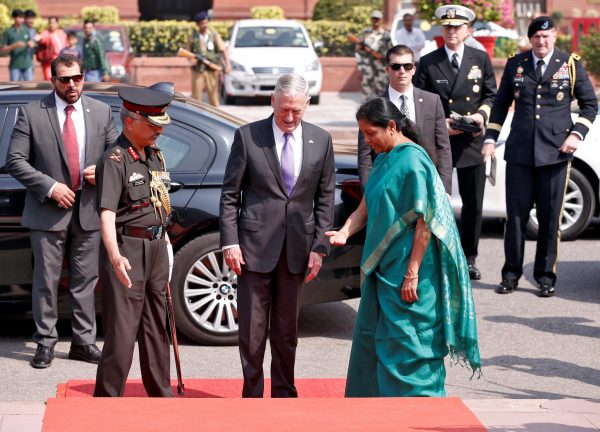When Modi delivered his landmark speech at the Shangri-La Dialogue in Singapore on 1 June 2018, there was no mention of India’s concerns over Chinese assertiveness in the South China Sea. Nor did Modi explicitly mention the ‘quadrilateral’ — the emerging strategic grouping that includes India, the United States, Japan and Australia which aims to counter an increasingly assertive China.
Initially conceptualised by Japanese Prime Minister Shinzo Abe in 2007, the first quadrilateral idea was short-lived. Diplomats and strategic pundits who supported the quartet continued to refer vaguely to the initiative, but no substantial progress was made towards cohesive negotiations. Almost a decade later, the quadrilateral made a comeback on the sidelines of the East Asia Summit and ASEAN Summit held in Manila in November 2017. Whether the momentum will last is unclear.
Perceptible limits to India’s enthusiasm is one of the reasons underlying this uncertainty. India fears provoking China at a time when US commitment to regional security is perceived as unreliable. Besides, India has its own historical antipathy, rooted in ‘non-alignment’, to regional power blocks or groupings that can be interpreted as security-centric or military alliances. India’s hedging approach — both seeking to contain and engaging directly with China — may be politically expedient.
With India reluctant to cede power to a formalised security alliance led by the United States, China is shrewdly trying to counter escalating tensions with the Trump administration by mending fences with India and Japan.
But Modi is not entertaining a romanticised notion of building an Asian century in collaboration with China. Not referencing the quadrilateral in his speech was a deliberate attempt to hide the overtly strategic contours of the ‘Indo-Pacific’ concept and what exactly it entails besides enlarging the maritime dimension of India’s ‘Act East’ policy.
The prospects of a real ‘reset’ between India and China look increasingly suspect, in contrast to New Delhi’s generally favourable relations with Washington since the late 1990s when India embarked on a major shift in its developmental and foreign policy strategy. After having almost negligible defence ties during the Cold War, India has since become a ‘Major Defence Partner’ of the United States. While the relationship seems to have experienced some coolness under the Trump administration, the two countries have come a long way. The Pentagon renamed its Pacific Command the ‘Indo-Pacific Command’ in an attempt to put India at the centre of security strategy, though the move is largely symbolic.
On the other hand, the India–China relationship has ebbed and flowed since Modi became India’s prime minister in 2014. China has been playing with India, alternately confronting and befriending it. For instance, in September 2014, Chinese troops entered the Chumar region in Ladakh (a contested section of the border) just as President Xi Jinping was visiting India. And in July 2017, China challenged India on the Doklam Plateau, a tri-junction between India, China and Bhutan.
After a prolonged standoff, China withdrew and while the diplomatic talk was quiet, many Indian analysts claimed success. But China’s incursion raised uncomfortable questions about India’s strategic vulnerabilities. Beijing had openly challenged India’s regional influence and asked a committed Indian ally — Bhutan — to make a choice. The intractable border dispute, the contentious issue of Tibet, bitter memories of the 1962 India–China war and China’s rising assertiveness in the Indian Ocean all overshadow attempts by the two countries to use trade as a healer.
There is also some anxiety that China’s increasing assertiveness may force India to abandon some of its strategic autonomy from the United States, particularly its relationships with Russia and Iran. Desire for freedom from external pressure may have prompted Modi to remain cautious about fitting the Indo-Pacific into the quadrilateral framework. But it may have also revealed him to be incapable of acting on his own brand of unilateral, risk-taking and centralised foreign policy.
Since China’s energy-hungry and export-driven economy is heavily dependent on raw material and fuel imports, Beijing is seeking to prop up its influence over the regional sea lines of communication that are critical to the entire Indo-Pacific community. Beijing is able to exercise increasingly muscular capabilities and severely constrain actions that it finds offensive. Even in South Asia, India’s traditional sphere of influence, India is increasingly overshadowed economically and encircled militarily.
There is an urgent need to consolidate the quadrilateral as a meaningful strategic community for counterbalancing China’s relentless efforts to expand its geopolitical reach in Asia. Since China’s military posturing challenges both India and the United States, Washington is keen on leveraging its strategic ties with New Delhi to balance the rise of China in the larger Indo-Pacific domain. India’s vacillation on the quadrilateral could leave it with difficult strategic choices.
Vinay Kaura is Assistant Professor and Coordinator of the Center for Peace and Conflict Studies, Sardar Patel University of Police, Security and Criminal Justice.

